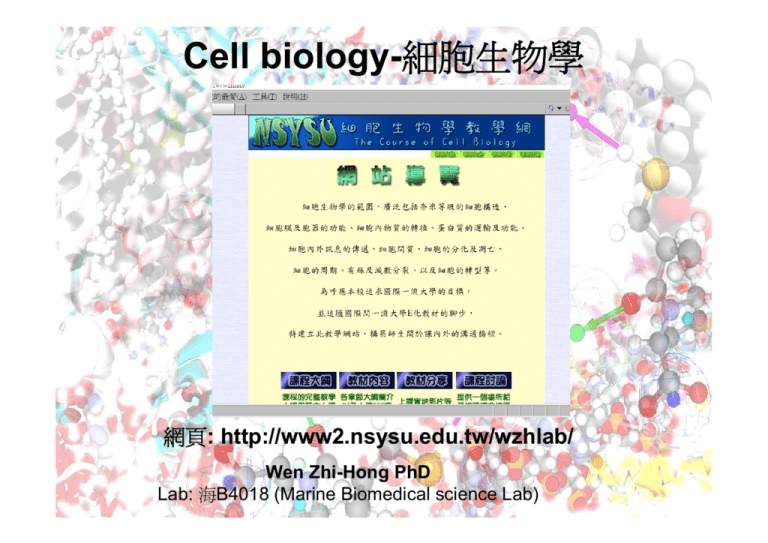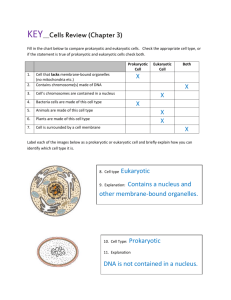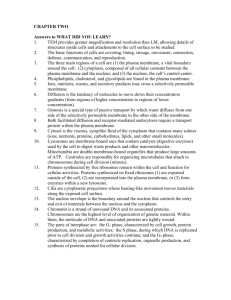Cell biology
advertisement

Cell biology-細胞生物學 網頁: http://www2.nsysu.edu.tw/wzhlab/ Wen Zhi-Hong PhD Lab: 海B4018 (Marine Biomedical science Lab) Textbook Molecular Cell Biology, 6th edition, Harvey Lodish et al., 2008, W. H. Freeman and Company. 買一本好書可以用很久 買一本難的書可以使用更久 www.whfreeman.com/lodish Reference Textbook • Molecular Biology of the Cell, 4th edition, Bruce Alberts et al., 2002, Garland Science. Essential Cell Biology, Second Edition 評分標準: 16次小考平均(85%) + 出席 (15%) = 100 % 全班總成績最高定為99分 去年全班51人原始平均(大二74.3;大三以上81.5) 請假:請事先提出相關證明及假條,臨時病假請事後提出 就醫證明 考試時間:週三 9:00-9:15 (上課前) 考試題型: 選擇題 是非題 填空題 簡答題 考試內容: 書本原文, 各大研究所考題, 上課必考題 補考措施 請事假者:補考第一次打八折,第二次打七折…… 請公假者:補考第一次不打折,第二次打九折…… 請病假者:補考第一次不打折,第二次打九折………………… 期末考週統一補考 預計章節 1. Life begins with cells 2. Chemical foundations 3. Protein structure and function 4. Basic molecular genetic mechanisms 5. Visualizing fractionating, and culture 6. Biomembrane structure 7. Transmembrane transport of ions and small molecules 8. Move protein into membrane and organelle 9. Vesicular traffic, secretionk and endocytosis 10. Microfilaments-I 11. Microtubules and intermediate filaments 12. Nerves cells Lodish • Berk • Kaiser • Krieger • Scott • Bretscher •Ploegh • Matsudaira • MOLECULAR CELL BIOLOGY • SIXTH EDITION • CHAPTER 1 • Life Begins with Cells ©Copyright 2008 W. H.©Freeman andand Company 2008 W. H. Freeman Company 細胞的發現 西元1665年,英國科學家虎克(Robert Hooke)首次 以自製的顯微鏡,觀察軟木塞,看到許多蜂窩狀的 小格子,並以拉丁文cellulae (小房間之意)命名之 ---細胞(CELL)的由來 羅伯特.胡克所用 的顯微鏡 胡克觀察到的栓 皮細胞 細胞學說(cell theory): T. Schwan ( 動物學家 ) 和 M. Schleiden ( 植物學家 )提出細胞學 說。(1839-1840) (一) 細胞是構成生物體的基本單位。(unit of structure) (二) 細胞是生物體的基本生理單位。(unit of physiology) (三) 細胞是生物體的發育單位;或 “All arise from pre-existing cells. 多細胞生物的組成層次 細胞 組織 器官 系統 個體 1.構造或機能相似的細胞,集合一起稱為組織。 2.數種不同的組織集合一起以完成某種生理機能者稱為器官。 3.幾種機能相同的器官聯合而成系統。 4.人類及其他脊椎動物具有多種系統,各系統互相分工合作而表現 各種生命現象。 多細胞生物的組成層次 胞器(粒線體) 分子 細胞 組織 器官 個體 細胞有多大? m=米 mm= 毫米 =(10-3m):肉眼可見的範圍 um=微米=(10-6m):光學顯微鏡可見的範圍 nm=奈米=(10-9m):電子顯微鏡可見的範圍 細胞的大小約為數百至數微米,大型細胞如鳥類的卵細 胞,直徑可達10公分,神經細胞可達一公尺 Single cell → multiple cell → complex structure, organ… → body It grow, reproduces, process information, respond to stimuli and carry out an amazing array of chemical reactions. → define life Cell biology is a integrative science that brings together biochemistry, biophysics, molecular biology, microscopy, genetics, physiology, computer science and developmental biology. The diversity and commonality of cells Some move rapidly and have fastchanging structure (amoebae and rotifers輪蟲) Oxygen: skill or absolute requirement. Most organisms are multiple cell Unicellular organisms live. Such as the bacteria that live in our intestines and help us digest food. A single ~200 mm cell, the human egg, with sperm, which are also single cells. From the union of an egg and sperm will arise the 10 trillion cells of a human body. 真細菌eubacteria A colonial singlecelled green alga 古細菌archaebacteria Blood cell purkinje Epithelial cell Plant cell Cells come in a astounding (令人驚奇) assortment (分類) of shapes and sizes Prokaryotic cell: outer has plasma membrane but lacks a defined nucleus, and has a relatively simple internal organization. Bacteria (blue-green algae, cyanobacteria), the most numerous prokaryotes which are single –celled organisms. There is no membrane-bounded compartments, however many proteins are precisely localized in their aqueous interior, or cytosol → internal organization. One E coli bacterium 2.5 x 10-14 g; In earth, about 5 x1030 → 1012 kg ; one people about 70 kg Eukaryotic cell: contain a defined membrane-bound nucleus and extensive internal membranes that enclose compartments (organelles) Golgi vesicles: process and modify proteins. Mitochondria: generate energy Lysosomes: digest cell materials to recycle them. Peroxisomes: precess materials to the surface to release them. It comprise all members of the plant and animal kingdoms E coli WBC Nucleus outer membrane is continuous with the rough endoplasmic reticulum → golgi vesicles process and modify proteins All cells are prokaryotic or eukaryotic Prokaryotic vs. Eukaryotic Cells Prokaryotic cells – No Nucleus – No Organelles – Cell Wall of peptidoglycan – Binary Fission – 1 circular chromosome – Small Eukaryotic Cells – Nucleus – Organelles – If cell wall, Cellulose or chitin – Mitosis – Linear chromosomes – 10-100um across All organisms form simple bacteria to complex mammals probably evolved from a common, single celled progenitor 真細菌 枯草桿菌 硫葉菌 古細菌 甲烷桿菌 極端嗜熱菌 嗜鹽球菌 黃桿菌 嗜鹽桿菌 甲烷球菌 綠硫菌 伯氏疏螺旋菌 瘧原蟲 n is o i t a m r Transfo s is o p r o m a meta 孢子形成 裂殖子 配子體 SEM of mature oocysts and emerging sporozoites (孢子 體). Oocytes (成熟卵母細 胞): external surface of stomach wall cells and are encased with a membrane that protects them form the host immune system. Plasmodium organisms (多核的原生質團), the parasites that cause malaria, are single celled protozona with a remarkable life cycle Merozoites (裂殖子) Even single cells can have sex 單配體細胞生長 產生孢子 Ascospores:囊孢子 Ascus:子囊 減數分裂 The yeast reproduces sexually and asexually, it had different mating type (a, α) Viruses are the ultimate (最終的) parasites Virus must infect a host cell to grow and reproduce Chicken pox水痘, influenza流行性感冒, pneumonia肺炎, polio小兒麻痺, rabies狂犬病, hepatitis, AIDS, common cold ect. We develop from a single cell In 1827, German physician Karl von Baer Discovered: sperm cell + egg → fertilization → zygote (200μm) → development → proliferation → differentiation → cell type → body The first few cell division of a fertilized egg set the stage for all subsequent development Stem cells, cloning and related technique offer exciting possibilities but raise some concerns Embryonic stem cell (EC cell) Reproduce copy: 1. Early stage of embryo → separated → five groups cell → implanted to mother → produced five copy sheep. 2. Multiple single-celled embryos → remove nuclei → injection Five genetically identical cloned sheep adult nuclei →implanted to mother → developed Early cytoplasm had many or unknown factor→ induced development The molecules of a cell Small molecules carry energy, transmit signals, and are linked into macromolecules Much of the cell’s contents is a watery and small molecules. The function of small molecule: Energy: ATP, photosynthesis related signal transduction: hormone, neurontransmitter formation of macromolecule : monomer → polymer → macromolecule such as cytoskeleton, protein, nucleic acid Proteins give cells structure and perform most cellular tasks Form 20 different amino acids Only protein has functions Amino acid → peptide → poly peptide →10→ 20→30→40→ functional protein Protein family: are similar to one another and therefore can be considered members Enzyme: catalyst Protein vary greatly in size, shape and function Nuclei acids carry coded information of making protein at the right time and place DNA: deoxyribonucleic acid, consist from nucleotide (ATCG) Double helix, and complementary ; also called gene One gene define = may produced protein Human about 40000 gene T C A G Cells use two processes in series to convert the coded information in DNA to protein First, transcription (DNA→ mRNA) RNA polymerase Messenger RNA Transcription factor Second, translation (mRNA → protein) Ribosome The coded information in NDA is covered into the amino acids sequences of proteins by a multistep process The genome is package into chromosomes and replicated during cell division Most of the DNA is located in the nucleus → extensively folded into the familiar structures → chromosomes Genome: an organism comprises its entire complement of DNA. Human 46 chromosomes: half the gene form mother, other half form father Male :XY; Female: XX, one x chromosome → barr body, not activity and transcription. Multiplex fluorescence in situ hybridiation; M-FISH The work of cells Plasma membrane: separated from the external environment Plasma membrane consist from two layers of Phospholipid molecules. Water-loving: hydrophilic; water hating: hydorphobic In eukaryotic cell: cytosol and internal spaces of organelles differ form the cell external in terms of acidity, ionic composition and protein…. The watery interior of cells is surrounded by the plasma membrane Cells build and degrade numerous molecules and structure Mitochondria or chloroplast: ATP recycle Lysosome: has many enzyme for degrade protein.. Peroxisome: degrade lipid Endoplasmic reticulum (ER) & golgi apparatus: protein production and modification Cells change shape and move network of protein fibers running throughout the cytoplasm that give a cell its shape & provide a basis for movement (cytoplasmic streaming) cytoskeleton microfilaments (actin*) about 7 to 8nm dia & of indefinite lengths. It is a universal eukaryotic protein 5% of total cell protein intermediate filaments... (10nm dia ex: keratin, vimentin & lamin) protein fibers [rope-like] with an intermediate diameter spans cytoplasm providing framework for mechanical strength made from a heterogeneous family of filamentous proteins microtubules... 25nm dia tubulin proteins (highly conserved evolutionarily) 21-25 nm dia, up to several um long make long fibrillar protein complexes that form spontaneously repeating globular units: 2 different proteins: alpha & beta tubulin Cells sense and send information Hydrophilic ligands bind to cell-surface receptors Examples: Ion-channel-linked receptors G-protein-linked receptors Enzyme-linked receptors Non-enzyme-linked receptors Hydrophobic ligands diffuse across the plasma membrane and bind to intracellular receptors in the cytoplasm or the nucleus Examples: Nuclear receptors for steroid and thyroid hormones, retinoids, Vit D Cells grow and divide Cell cycle, mitosis; a parent cell into two daughter cell The eukaryotic cell cycle had four stages: S: synthesis phase M: mitotic phase, replicated chromosomes separate G1 and G2 phase: mRNA and protein are made During interphase, which consists of G1, S and G2 phase, the cell roughly doubles its mass. Under starvation or when a tissue has reached its final size, cells will stop cycling and remain in a waiting state called G0. Dad made you a boy or girl Meiosis Diploid Haploid Gamete Autosome (44 chromosomes) 2 (X or Y) are sex chromosomes Die from aggravated assault or an internal program Apoptosis: programmed cell death, a dying cell actually produces proteins necessary for self-destruction It can prevent release damaged chemical to hurt other cells. apoptosis Investigating cells and their parts m:10-3 m → symbol →μ : 10-6 n: 10-9 p: 10-12 f: 10-15 • 毫米mm (mini-meter) • 微米μm (micro-meter) • 奈米nm (nano-meter) Cell biology reveals the size, shape, and location of cell components Micoscopes Confocol micoscopes Antibody Fluorescent protein or chemcial Biochemistry reveals the molecular structure and chemistry of purified cell constituents Genomics reveals differences in the structure and expression entire genomes DNA microarray Proteome (蛋白體) Proteomics (蛋白質體學) Genome (基因體) Genomics (基因體學) Development biology reveals changes in the properties of cells as they specialize Different gene expression → different protein expression → different cell physiology Choosing the right experimental organism for the job Molecular divination → in vitro (cell model) → in vivo → A genome perspecitve on evolution Meatbolic proteins, the genetic code, and organelle structure are nearly universal Many genes controlling developmental are remarkably similar in humans and other animals Similar genes, conserved during evolution, regulate many developmental processes in diverse animals 別忘了下週三,同一地點及中原標 準時間 早上9:00要小考。 9:15要收考卷








